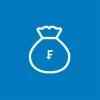In recent years, many Swiss banks have grown their palette of pillar 3a investment products, and have actively promoted these. That is true for both the conventional retirement funds evaluated in this study, and for digital pillar 3a asset management services, which moneyland.ch analyzed in a separate study published on October 26, 2022. In spite of the increasing popularity of asset management for retirement savings, the bulk of pillar 3a investments are still made using conventional retirement funds. For that reason, moneyland.ch studied the costs and performance of the most important retirement funds.
Retirement funds cost over 1 percent per year
“The total costs are a particularly important factor to consider when choosing the right retirement fund,” says moneyland.ch analyst Felix Oeschger. In order to find out how much Swiss pay to invest their retirement savings, moneyland.ch analyzed the total costs of 81 different retirement funds. The combined fees and costs of a fund are normally indicated by its total expense ratio (TER). But this term is somewhat misleading because other costs may apply in addition to the TER. That is why the total costs used by moneyland.ch also account for possible sales charges, custody fees, flat fees, and deferred sales charges, rather than just the TER.
The results show that the average total cost across all of the analyzed retirement funds is 1.09 percent per year. But the actual costs of individual funds vary enormously.
The total cost of investing 100,000 francs over a 10-year investment term using the most expensive fund would be 17,000 francs, which translates into 1.7 percent of the invested capital per year. Of the retirement funds which invest in stocks or bonds, the total cost of the most affordable stock fund is 3500 francs, or 0.35 percent per annum.
Cheaper passive retirement funds
Many passively-managed retirement funds have come onto the market in recent years. Many of these funds have large stock components. The average total annual cost of actively-managed funds is 1.17 percent, compared to 0.65 percent for passively-managed funds.
Outside of the pillar 3a, it has long been acknowledged that passively-managed funds perform better, on average, than actively-managed ones. Over long investment horizons in particular, actively-managed funds rarely perform better than the market as a whole. “Passively-managed funds should generally be prioritized – including for retirement saving,” observes Oeschger.
How important is performance?
In addition to total costs, moneyland.ch also compared the past performance of 81 Swiss retirement funds. Performance calculations accounted for TERs, but not for other costs like custody fees and sales charges. The calculations account for performance up until the end of September 2022, with separate calculations for the past year (end of September 2021 until end of September 2022), and the past three, five, and ten years.
Historical performance should not be over-emphasized when choosing a retirement fund. Just because a fund performed well in the past, that does not mean it will continue to perform well in the future. “The only thing you can count on is that costs will detract from performance,” explains moneyland.ch CEO Benjamin Manz.
Negative performance over the past year
Swiss retirement funds have not remained unscathed by the turbulence in the stock market. Since the beginning of the year, both stocks and bonds have massively declined in value. Because these two asset classes make up an average of 90 percent of the investments held by Swiss retirement funds, all of the 81 funds analyzed have lost value over the past twelve months. Negative performance was somewhat lower for funds with below-average stock and bond components, and larger investments in other asset classes like real estate or the money market.
Between the end of September 2021 and the end of September 2022, the value losses of analyzed funds ranged between 0.9 and 19.8 percent. Both the average and the median performance across all funds is -13.6 percent. “That means every second retirement fund lost 13 percent of its value,” says Felix Oeschger from moneyland.ch.
By comparison: The Swiss Market Index (SMI) fell by 9.3 percent across the same period, and the broader Swiss Performance Index (SPI) fell by 12.5 percent. The Swiss Bond Index (SBI), which tracks price developments across the similarly-important Swiss market for bonds, fell by 11.8 percent.
Mid- to long-term performance
When you compare performance across the past three, five, and ten years, it becomes noticeable that the longer the investment term is, the better the funds with larger stock components perform in relation to other funds. That is linked to the fact that over long terms, stocks have historically performed better than less risky and less volatile asset classes. Retirement funds with large stock components have suffered under the recent drops in stock prices. “But from a historical perspective, a well-diversified stock portfolio can recover from temporary crashes over the long term,” says Oeschger.
The average performance of analyzed funds across the past three years was -3.1 percent. The worst-performing funds lost 14.7 percent of their value, while the value of the best-performing funds went up by 12.3 percent.
Average performance across the past five years was 1.7 percent. Performance of individual funds ranged between -13.1 percent for the worst performer to +15.6 for the best-performing retirement fund.
For the long, ten-year investment term, performance ranged between -9.8 percent and +54.5 percent. On average, the value of Swiss retirement funds went up by 23.4 percent, which translates into a 2.1 percent annual return. Over the same time frame, the SMI went up by 117 percent and the SPI went up by 119 percent. The SBI fell by 1.4 percent.
The main reason why the 81 Swiss retirement funds analyzed by moneyland.ch performed so poorly compared to the Swiss stock market indexes is that they have relatively small stock components. The average stock component is less than 50 percent. Additionally, most of the retirement funds with large stock components (70 percent or more) have only been launched in the past few years. Only around half of the 81 retirement funds have performance data going back ten years, and not a single one of those that do has a stock component above 70 percent.
Two steps to finding the right pillar 3a fund
First step: Choose the stock component yourself. For long investment terms, stocks perform better than other asset classes – or at least they have in the past. The longer the investment horizon is, the bigger a stock component you can use. The rule of thumb: You should only invest in funds with very high stock components if you will leave the money invested for at least ten years. If volatility makes you nervous, or if you will only leave the money invested for a few years, then you should use funds with small stock components.
Second step: Once you have decided on the right stock component, you should look for the cheapest available retirement fund with that stock component. Or you can divide your pillar 3a assets up, with part of them invested in a stock-heavy retirement fund, and the rest of them deposited into the pillar 3a savings account with the highest interest rate.
Example: If you only want 50 percent of your pillar 3a savings invested in the stock market, you can invest half of your assets in an affordable retirement fund with a high stock component of 90 percent or more. You can then deposit the other half in the pillar 3a savings account which pays the highest interest. When choosing funds, you should look at the costs, and not the past performance. Alternatively, you can use a low-cost pillar 3a asset management service. These are often much cheaper than conventional retirement funds.
Methodology
moneyland.ch analyzed the costs, conditions, and returns of 81 conventional Swiss retirement funds. The study only included stand-alone retirement funds with their own individual ISINs, and did not account for pillar 3a asset management services.
Total costs were calculated based on a constant investment of 100,000 Swiss francs across the full term. Calculations are based on the assumption that the investor will buy shares in the fund at the start of a 10-year term, and sell them at the end of the term. In addition to the TER, the total costs also account for custody fees, sales charges, deferred sales charges, and flat fees.
Performance was calculated based on the total return model, with the assumption that returns and dividends remain in the retirement fund and are reinvested without generating commissions, duties, or taxes.
The cost and performance figures used are those provided by fund managers as per October 2022. TERs are already deducted from performance figures published by fund managers, but custody fees, sales charges, and flat fees are not.
The TER’s published by fund managers account for the operating expenses of funds. Costs which are not accounted for in TERs but are accounted for in the total costs calculated by moneyland.ch include custody fees (for the safekeeping of fund shares), sales charges, deferred sales charges, and flat fees. For funds which publish their TER KGAST or synthetic TER, these figures were used for calculations. TERs are calculated ex post.
More on this topic:
Get the detailed results of the study (German PDF)
Compare Swiss retirement funds now
The cost of Swiss retirement saving app compared
Compare Swiss pillar 3a savings accounts now

 Deal of the Day
Deal of the Day 





